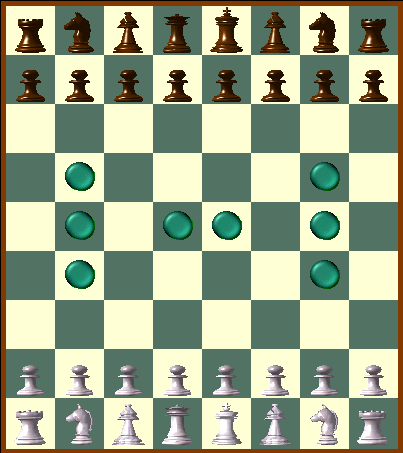EIGHT-STONE CHESS
Eight-Stone Chess is a large chess variant developed by Jim Aikin. It is played on an 8x9 board, and uses the normal complement of chess pieces, plus eight neutral pieces called stones. The normal pieces all use their normal moves (including castling and en passant), and a stalemate is a draw.
The opening setup for Eight-Stone Chess is as shown below. The black pieces are shown as lower-case letters surrounded by asterisks, and the stones are represented 'O'. Note that it's easy to play Eight-Stone Chess on a conventional chessboard. All you have to do is position the white or black pieces (but not the pawns) off the edge of the board.
 |
+---+---+---+---+---+---+---+---+ |*r*|*n*|*b*|*q*|*k*|*b*|*n*|*r*| +---+---+---+---+---+---+---+---+ |*p*|*p*|*p*|*p*|*p*|*p*|*p*|*p*| +---+---+---+---+---+---+---+---+ | | | | | | | | | +---+---+---+---+---+---+---+---+ | | O | | | | | O | | +---+---+---+---+---+---+---+---+ | | O | | O | O | | O | | +---+---+---+---+---+---+---+---+ | | O | | | | | O | | +---+---+---+---+---+---+---+---+ | | | | | | | | | +---+---+---+---+---+---+---+---+ | P | P | P | P | P | P | P | P | +---+---+---+---+---+---+---+---+ | R | N | B | Q | K | B | N | R | +---+---+---+---+---+---+---+---+ |
In each turn, the player must move one of his or her own pieces. In the same turn, the player may follow the piece move with a move by a stone, if desired. The stone move is optional, but the piece move is mandatory; if the player cannot make a legal piece move, he or she is stalemated, even though legal stone moves will still be available. The stone move must always follow the piece move in a given turn.
A player may not move a stone in such a way as to place his or her own king in check. A stone move may be used to eliminate a check, however. The player may move a piece in such a way as to leave his or her king in check, but must then make a stone move that eliminates the check.
STONES
The stones are neutral, and may be moved by either player. A stone cannot capture a piece, nor can it be captured. The eight stones remain in play throughout the game. A stone on a given square blocks the movement of pieces exactly as if the stone were a friendly piece. (Knights can leap over stones, for example.) Two stones cannot occupy the same square, nor can a piece or pawn occupy the same square as a stone.
A stone move consists of one of the following:
- A single stone may be moved vertically or horizontally by a single square,
to any adjacent vacant square.
- If a friendly piece (a piece belonging to the player making the stone move)
is on a square vertically or horizontally adjacent to a stone, the stone may
swap places with the piece. A player cannot move a stone in such a way as to
have it swap places with an enemy piece, however.
- When a group of two or more stones is arranged in an unbroken vertical or
horizontal line with a vacant square at either end of the line, a stone at one
end of the line can be picked up and moved to the vacant square at the other end
of the line. The line must consist entirely of stones, with no pieces or pawns
intervening.
- Ko rule: A stone cannot be moved back to the same position it occupied before the most recent turn by the opponent.
Strategy note: A piece that is threatened with capture while sitting on a square adjacent to a stone is more or less a sitting duck. Your opponent can capture it and then, in the same turn, swap the positions of the capturing piece and the stone, which will quite likely leave you no way to recapture.
Eight-Stone Chess (c) 1999 Jim Aikin. All rights reserved.
Pictures of an Eight-Stone chess board are here.
Written by Jim Aikin. HTML conversion by David Howe.
This variant is an entry in the 1999 Large Variant contest.
WWW page created: January 8, 1999. Last modified: May 8, 1999.
